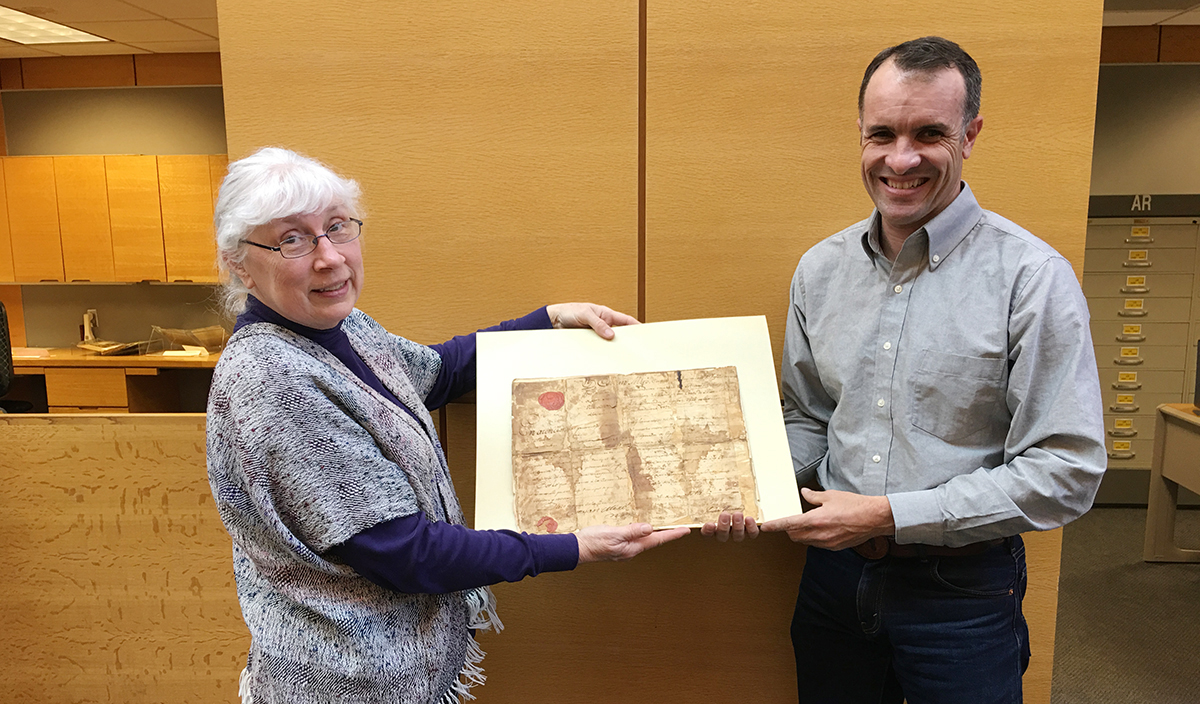Scholars help solve a century-old mystery

LAWRENCE – Exactly 234 years since it was signed and sealed with red wax and 113 years since the Kansas Historical Society obtained it, a chance meeting between a University of Kansas Spanish scholar and a KHS archivist has resulted in the document’s translation and posting to the internet, furthering the possibilities for digital scholarship.
The document in question is dated March 15, 1784. It is addressed to a representative "de la Nacion Ayoas" – of the Iowa(y) nation – and signed by Col. Don Estevan Miró, then the Spanish colonial governor of Louisiana. It had not been translated since KHS received it from a member of the Iowa tribe, presumably a descendant of the original recipient, over a century ago.
That changed last week when KU doctoral student of Spanish history Paul Schwennesen arrived at the archives in Topeka to work on an unrelated project. While consulting old Atchison, Topeka & Santa Fe Railway maps of the Southwest, KHS Director of Reference Lin Fredericksen, who was helping Schwennesen, saw that he knew early forms of Spanish. Fredericksen remembered the Miró document and wondered whether it could be translated. Turns out, with a bit of help from other scholars, it could and it was.
“I was at KHS doing some research for my mentor, who lives in New Mexico, looking up railroad records from the 1890s,” Schwennesen said. “While working with the KHS researcher, kind of in passing, I told her my primary research interests are in Spanish history in the new world, and her eyes lit up. She said, ‘We’ve had this document in the collection for a while, and we really don’t know what it says. It’s in an old form of Spanish that nobody can understand, and I would love to know what it says.’
“I said, ‘I’ll give it a shot.’ My mentor, Dr. Richard Flint, is one of the world’s experts in this field. They showed me a copy, and right off the bat, I could make out 25 to 30 percent of it. I said between my mentor and I, we could get it translated and transcribed, so we did.”
KHS provided Schwennesen with a digital copy of the 1784 letter, and he corresponded with Flint – who was in Spain at the time – via email on their translation of the document. Robert Schwaller, KU assistant professor of history, also contributed to the translation.
Schwennesen said the letter deals with territory in the modern American Midwest that had been given over to Spanish control by the French, who had lost it as the result of a war in Europe.
The Spanish, Schwennesen said, “were trying to create and re-establish their own direct relationships with a number of native nations. This document addresses an Indian leader named Yrugana, the Spanish phonetic transliteration for an Indian name pronounced Ee-roo-gana.
“What caught my eye was that Yrugana was representing what they called the nation of the Ayoas, or Iowas,” Schwennesen said. “This is one of the earlier formal acknowledgments of the Iowa people, which is, of course, where we ultimately get the state name from.”
Schwennesen said the document is “an agreement of mutual understanding and peace and good governance. There is nothing about trading territory. It’s rather a formal agreement not to be antagonistic.”
Schwennesen described some of the hard-to-understand writing as scribal shorthand that characterized official Spanish documents of this period. He and Flint provided translations of the letter first into modern Spanish and then into English, both of which have since been posted along with an image of the document at the KHS Kansas Memories website.
Fredericksen said the document is one of the oldest in the collection and had not been pulled often for research. However, she recalled a researcher who reached out to KHS about five years ago when a description of the document was posted online as part of a grant-funded archive-digitization project.
“A professor from back East called and said he wanted to find out more about this document,” Fredericksen said. “He knew all about this time period. Ever since, I always wanted a Spanish translation and an English translation so that people could find it through a search of the internet.”
Fredericksen said it was exciting to receive calls from researchers around the globe, “and the more stuff we get online, the more our collections will be used.”
Photo: Archivist Lin Fredericksen (left) and researcher Paul Schwennesen hold the 1784 Spanish document he helped translate for the Kansas Historical Society.